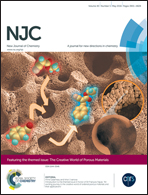Synthesis and characterization of π-conjugated copolymers based on alkyltriazolyl substituted benzodithiophene†
Abstract
A series of novel electron-donating building blocks of alkyltriazolyl substituted benzodithiophene were synthesized on the basis of Cu(I)-catalyzed azide–alkyne cycloaddition. The alternating donor–acceptor type of π-conjugated copolymers by using such alkyltriazolyl substituted benzodithiophene as donor units and diketopyrrolopyrrole as acceptor units were synthesized via Suzuki polymerization. The resultant copolymers exhibited good thermal properties and can be easily dissolved in various organic solvents. All copolymers show quite comparable absorption profiles in the range of 300–850 nm with the absorption onset at about 1.4 eV, where the copolymer with longer side chains exhibited a slightly enhanced absorption coefficient. The cyclic voltammetry measurements indicated the highest occupied molecular orbitals and the lowest unoccupied molecular orbitals located at about −5.40 and −3.40 eV, respectively, which were nearly independent of the size of alkyl side chains. Polymer solar cells based on the resultant copolymers as electron-donating materials and PC71BM as the electron-accepting material exhibited moderate photovoltaic performances.


 Please wait while we load your content...
Please wait while we load your content...